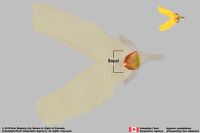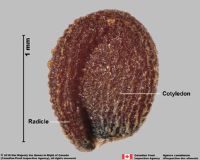Content is from Kirkbride et al. 2006Kirkbride et al. 2006:
Kirkbride JH, Jr, Gunn CR, and Dallwitz MJ. 2006. Family guide for fruits and seeds, vers. 1.0. Accessed September 2020-January 2022. URL: https://nt.ars-grin.gov/seedsfruits/keys/frsdfam/index.cfm ., without modification.
Updates are forthcoming.
Fruits: Pistil(s) compound; 1; 1-pistillate; with carpels united. Fruit anthocarpanthocarp:
simple or compound and including some tissue of non-ovarian origin (accessory tissue) ; simple; pseudodrupe; without persistent central column; crowned by sepalssepal:
; simple; pseudodrupe; without persistent central column; crowned by sepalssepal:
a member of the outer envelope of a flower (calyx) (spinescent calyx-limb which resembles 2–4 hornshorn:
(spinescent calyx-limb which resembles 2–4 hornshorn:
a straight or curved, slenderly conic or conoidal protrusion, resembling an animal horn
); with styles(s); at apexapex:
the point farthest from the point of attachment, or the "tip" of an organ ; within accessory organ(s); within calyxcalyx:
; within accessory organ(s); within calyxcalyx:
the outer whorl of the perianth; all the sepals of a flower ; connate; persistent; hard calyxcalyx:
; connate; persistent; hard calyxcalyx:
the outer whorl of the perianth; all the sepals of a flower ; 1-seeded; 1-seeded; with originally 2-carpellate (but 1 by arrest); with carpels united; with carpels remaining united at maturity; with carpels not radiating at maturity; with carpels remaining connected at stylestyle:
; 1-seeded; 1-seeded; with originally 2-carpellate (but 1 by arrest); with carpels united; with carpels remaining united at maturity; with carpels not radiating at maturity; with carpels remaining connected at stylestyle:
in a flower, the narrow and elongated part of the pistil between the stigma and the ovary; sometimes persisting in fruit ; without sterilesterile:
; without sterilesterile:
lacking male and/or female reproductive parts; also, not producing fruit or seed
 carpels; not sulcatesulcate:
carpels; not sulcatesulcate:
surface relief—having one or more elongate, relatively narrow and shallow depressions or grooves ; in transection flat; apexapex:
; in transection flat; apexapex:
the point farthest from the point of attachment, or the "tip" of an organ not beaked; wall woodywoody:
not beaked; wall woodywoody:
texture—consisting mainly of indurate lignified tissues, characteristic of or resembling wood
, or leatheryleathery:
texture—moderately thick, tough, and very pliable
; indehiscentindehiscent:
not opening on its own, as in a fruit
 . Epicarpepicarp:
. Epicarpepicarp:
outer layer of fruit wall or pericarp, if divided into layers; note here used synonymously with exocarp evanscent; membranousmembranous:
evanscent; membranousmembranous:
texture—extremely thin, pliable, and fairly tough
; glabrousglabrous:
without hairs
; without armature, or with armature; with horns; without armature glochidiate; smooth, or not smooth; without wing(s); without apicalapical:
at or pertaining to the end of the seed or fruit distal from its point of attachment (i.e., base)
respiratory hole. Mesocarpmesocarp:
the middle layer of the pericarp, if divided into layers absent. Endocarpendocarp:
absent. Endocarpendocarp:
the inner layer of the pericarp, if divided into layers present; not separating from exocarpexocarp:
present; not separating from exocarpexocarp:
outer layer of fruit wall or pericarp, if divided into layers; note here used synonymously with epicarp ; woodywoody:
; woodywoody:
texture—consisting mainly of indurate lignified tissues, characteristic of or resembling wood
, or bonybony:
very hard and rather brittle, like bone
; not splitting into 1-seeded pyrenes; not smooth; with laterallateral:
(of embryo) embryo lies along the side of the seed, generally towards one end; of, at, or from the side; in grasses, can refer to the sides adjacent to the dorsal and ventral sides
horns; without operculumoperculum:
a dehiscent cap (or lid) of a seed or fruit that opens during germination or dehiscence ; without secretory cavities; with mechanism for seedling escape; without longitudinallongitudinal:
; without secretory cavities; with mechanism for seedling escape; without longitudinallongitudinal:
of or relating to length or the lengthwise dimension
ridges; with apicalapical:
at or pertaining to the end of the seed or fruit distal from its point of attachment (i.e., base)
pore(s); 1-porate. Funiculusfuniculus:
(alt. funicle) stalk connecting the ovule (later seed) to the ovary (later fruit) placenta short; short without seed bearing hookswith hooks:
short; short without seed bearing hookswith hooks:
bristles or spines with curved or backwards pointing tips, or with secondary bristles along their length (retinacula); not persisting in fruit after seed shed.
(retinacula); not persisting in fruit after seed shed.
Seeds: Arilaril:
(broad sense) appendicular structure that wholly or partly envelops a seed and is produced from or a modification of the funicle, raphe, or outer integument; usually fleshy or pulpy, sometimes spongy or tufted-capillate, often brightly colored absent. Seed larger than minute (large); not bowl shaped; not nutlike; without winglike beakbeak:
absent. Seed larger than minute (large); not bowl shaped; not nutlike; without winglike beakbeak:
a usually firm, terminal appendage, sometimes tapered ; without caudatecaudate:
; without caudatecaudate:
tapering to a long, tail-like appendage appendage(s); at maturity without food reserves, or with food reserves; with endosperm; without canavanine. Sarcotestasarcotesta:
appendage(s); at maturity without food reserves, or with food reserves; with endosperm; without canavanine. Sarcotestasarcotesta:
pulpy or fleshy outer layer of the seed coat, simulates aril absent. Testatesta:
absent. Testatesta:
seed coat
 present; without markedly different marginalmarginal:
present; without markedly different marginalmarginal:
at, on, or close to the margin or border
tissue; without fleshy or leatheryleathery:
texture—moderately thick, tough, and very pliable
layer over hard layer; tight; surface unsmooth; without crease or line separating cotyledons from hypocotyl-radicle; without notch along margin where cotyledons from hypocotyl-radicle tip approach each other; without glands; without bristles; glabrousglabrous:
without hairs
; without wings; without collar; without operculumoperculum:
a dehiscent cap (or lid) of a seed or fruit that opens during germination or dehiscence ; colored; monochrome; membranousmembranous:
; colored; monochrome; membranousmembranous:
texture—extremely thin, pliable, and fairly tough
(upper part of testatesta:
seed coat
 spongyspongy:
spongyspongy:
soft, light, discontinuous but cohesive, and somewhat resilient
); not becoming mucilaginousmucilaginous:
resembling mucilage; moist and sticky
when wetted; surrounding embryo. Endosperm development nuclear. Embryo differentiated from food reserve; well developed; 1 per seed; completely filling testatesta:
seed coat
 (no food reserve); 1 times the length of food reserve; at one end of seed not extending into a depression or cup; foliatefoliate:
(no food reserve); 1 times the length of food reserve; at one end of seed not extending into a depression or cup; foliatefoliate:
appearing leaf-like
; straight; parallel to seed length; with cotyledons abruptly connected to hypocotyl-radicle; without coleorhiza; without simmondsin; without stomata; not green; with 2 or more cotyledons. Cotyledons 2; well developed (1, other vestigial); 0.8 times length of embryo; somewhat to significantly wider than hypocotyl-radicle; 4–6 times wider than hypocotyl-radicle; thick (1 large); smooth; with apicesapex:
the point farthest from the point of attachment, or the "tip" of an organ entire; with margins separate; unequal in size; markedly unequal; not punctatepunctate:
entire; with margins separate; unequal in size; markedly unequal; not punctatepunctate:
surface relief - dotted with pits or with translucent, sunken glands or with colored dots, similar to pitted dotted; one developed and the other scalelike & emerging (along with radicleradicle:
dotted; one developed and the other scalelike & emerging (along with radicleradicle:
the embryonic root of the embryo and plumule) through terminal pore left by fallen stylestyle:
and plumule) through terminal pore left by fallen stylestyle:
in a flower, the narrow and elongated part of the pistil between the stigma and the ovary; sometimes persisting in fruit . Hypocotyl-radicle small; straight; not thickened. Plumule minute; terminal between 2 cotyledons.
. Hypocotyl-radicle small; straight; not thickened. Plumule minute; terminal between 2 cotyledons.
General references: Baillon, H.E. 1866–95. Histoire des plantes, 13 vols. Hachette & Co., Paris, Corner, E.J.H. 1976. The seeds of Dicots, esp. vol. 2. Cambridge University Press, New York, Cronquist, A. 1981. An integrated system of classification of flowering plants, 1,262 p. Columbia University Press, New York, Gaertner, J. 1788–1805. De fructibus et seminibus plantarum. The Author, Stuttgart, Goldberg, A. 1986 (dicots) & 1989 (monocots). Classification, evolution, and phylogeny of the familes of Dicotyledons. Smithsonian Contr. Bot. 58 for dicots (314 pp.) & 71 for monocots (74 pp.). [Goldberg's illustrations are reproduced from older publications and these should be consulted], Gunn, C.R., J.H. Wiersema, C.A. Ritchie, & J.H. Kirkbride, Jr. 1992 & amendments. Families and genera of Spermatophytes recognized by the Agricultural Research Service. Techn. Bull. U.S.D.A. 1796:1–500, LeMaout, E. & J. Decaisne. 1876. A general system of botany, 1,065 p. Longmans, Green, & Co., London, Mabberley, D.J. 1987. The plant-book, 706 p. Cambridge University Press, Cambridge, and Spjut, R.W. 1994. A systematic treatment of fruit types. Mem. New York Bot. Gard. 70:1–182.